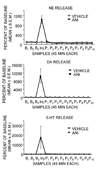Protein synthesis inhibition and memory: formation vs amnesia
- PMID: 18054504
- PMCID: PMC2346577
- DOI: 10.1016/j.nlm.2007.10.006
Protein synthesis inhibition and memory: formation vs amnesia
Abstract
Studies using protein synthesis inhibitors have provided key support for the prevalent view that memory formation requires the initiation of protein synthesis as a primary element of the molecular biology of memory. However, many other interpretations of the amnesia data have received far less attention. These include: (a) protein synthesis may play a constitutive role in memory formation, providing proteins prior to an experience that can be activated by training; (b) protein synthesis may be needed to replace proteins available prior to learning but 'consumed' by learning; (c) inhibition of protein synthesis impairs the well-being of neurons, leading to an inability to deliver resources needed for memory formation; and (d) inhibition of protein synthesis results in abnormal neural functions that interfere with memory. One of these, abnormal release of neurotransmitters after inhibition of protein synthesis, is detailed here, along with a review of many circumstances in which it appears that protein synthesis at the time of training is not required for the formation of new memories. Evidence of activation of cell signaling molecules and transcription factors is another form of support for a role of training-initiated protein synthesis in memory. However, recent findings suggest that many of these molecules are activated by training and remain activated for days after training, i.e. activated for times well beyond those typically invoked for memory consolidation processes. Reviewing these results, this paper suggests that the long-lasting molecular changes may be the basis of a form of intracellular memory, one responsible for up-regulating the probability that a neuron, once activated in this manner, will engage in future plasticity. This view melds ideas of modulation of memory with those of consolidation of memory.
Figures




References
-
- Abel T, Kandel ER. Positive and negative regulatory mechanisms that mediate long-term memory storage. Brain Research - Brain Research Reviews. 1998;26:360–378. - PubMed
-
- Barraco RA, Stettner LJ. Antibiotics and memory. Psychological Bulletin. 1976;83:242–302. - PubMed
-
- Bekinschtein P, Cammarota M, Igaz LM, Bevilaqua LRM, Izquierdo I, Medina JH. Persistence of long-term memory storage requires a late protein synthesis- and BDNF-dependent phase in the hippocampus. Neuron. 2007;53:261–277. - PubMed
-
- Bilang-Bleuel A, Rech J, De Carli S, Holsboer F, Reul JM. Forced swimming evokes a biphasic response in CREB phosphorylation in extrahypothalamic limbic and neocortical brain structures in the rat. European Journal of Neuroscience. 2002;15:1048–1060. - PubMed
Publication types
MeSH terms
Substances
Grants and funding
LinkOut - more resources
Full Text Sources
Medical

